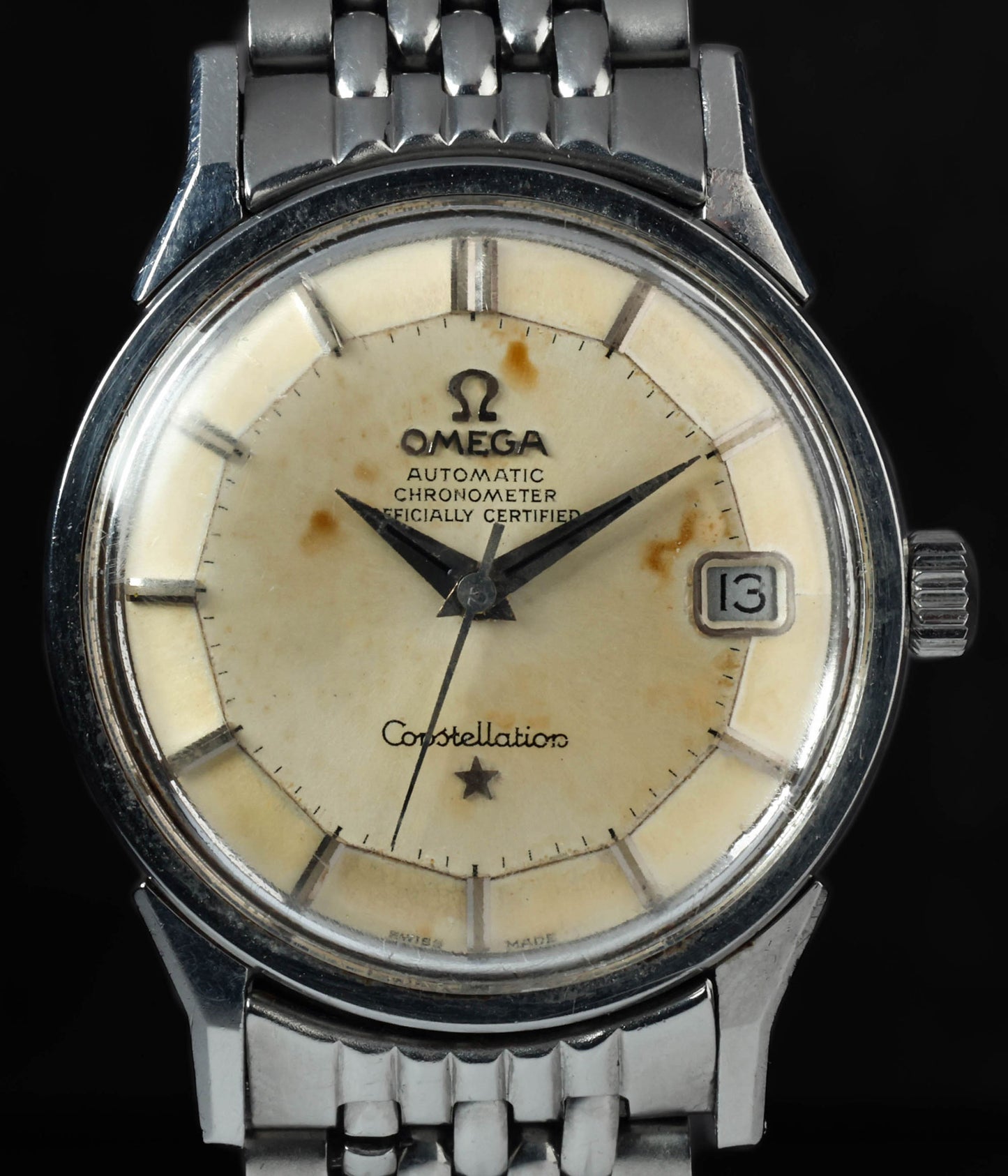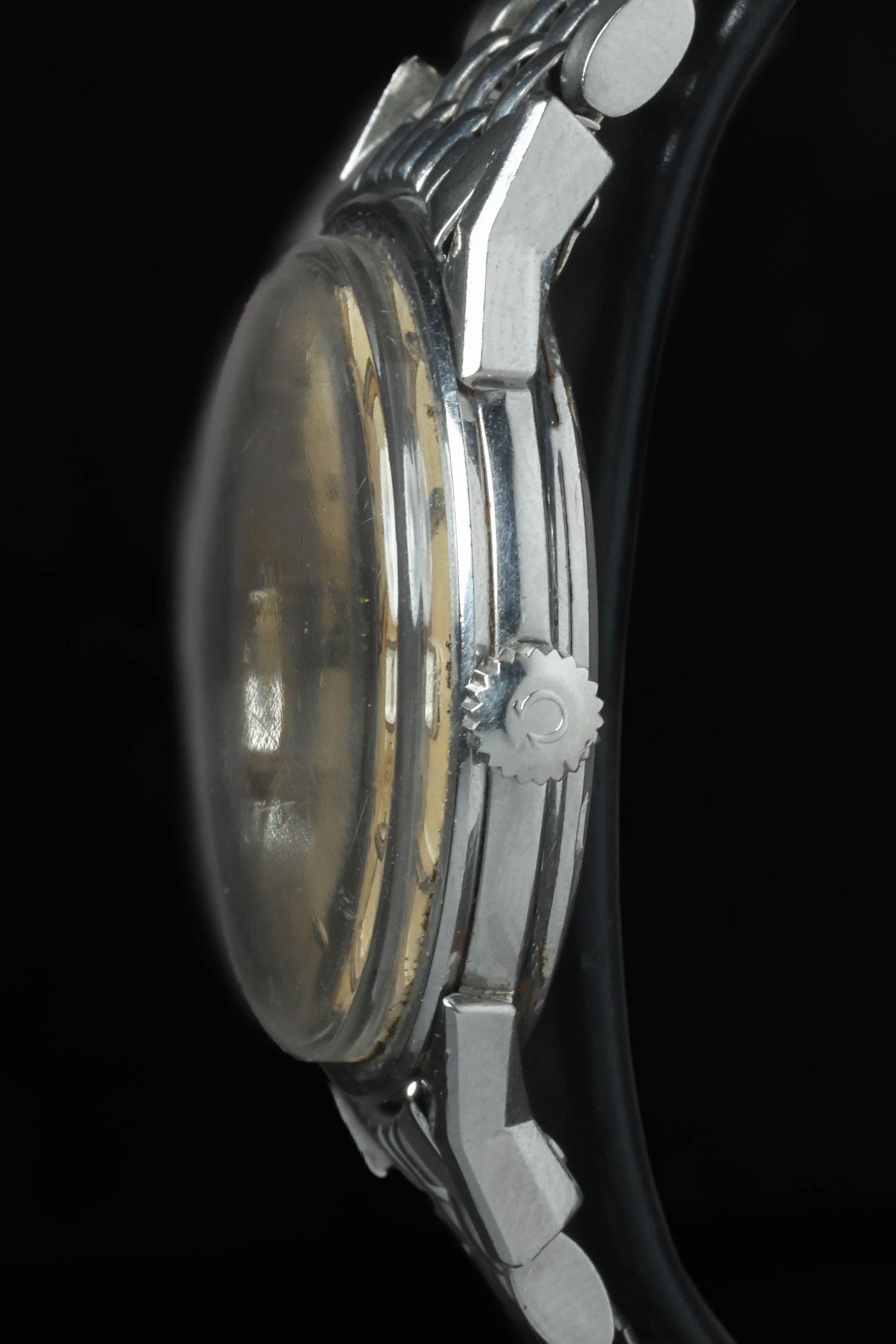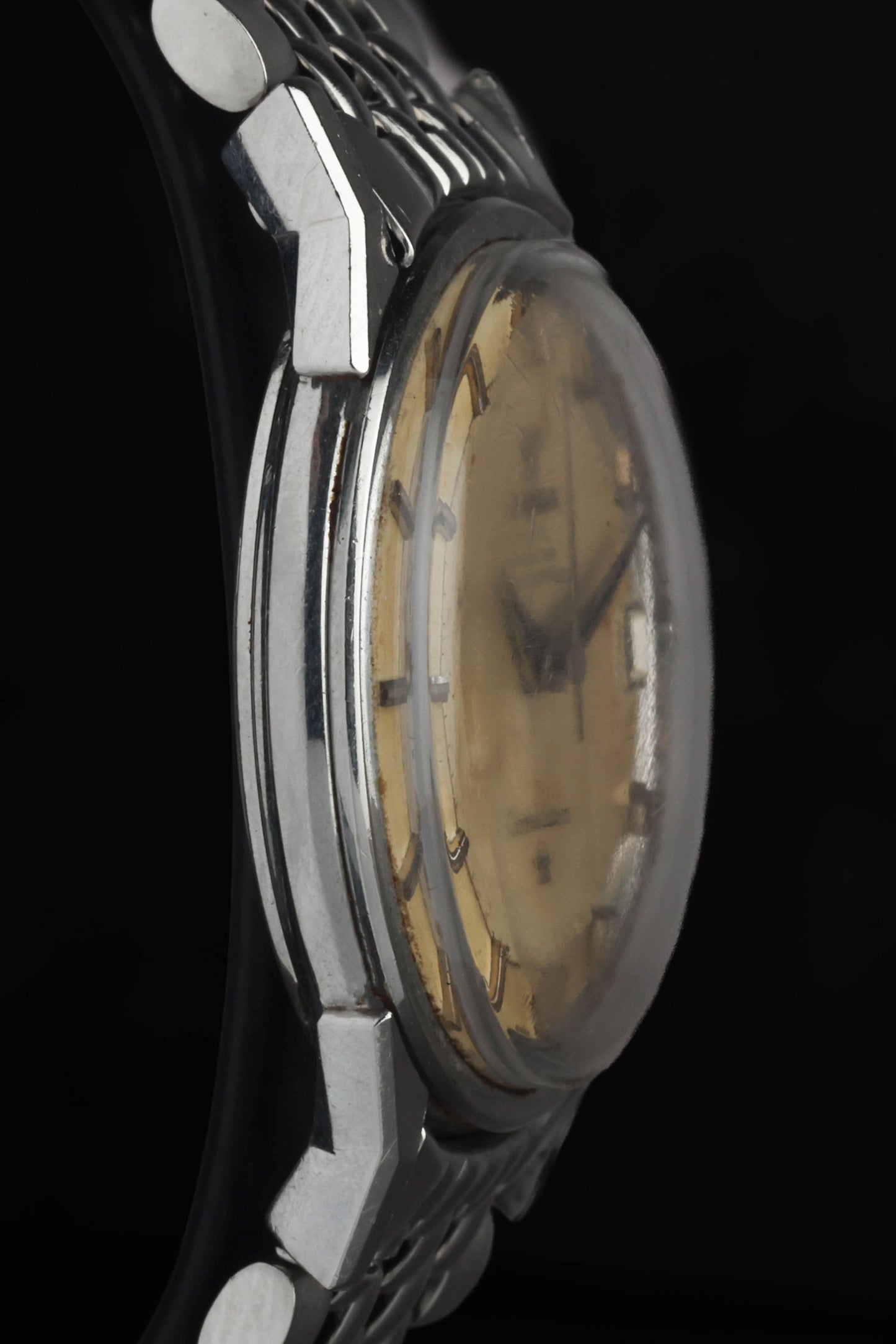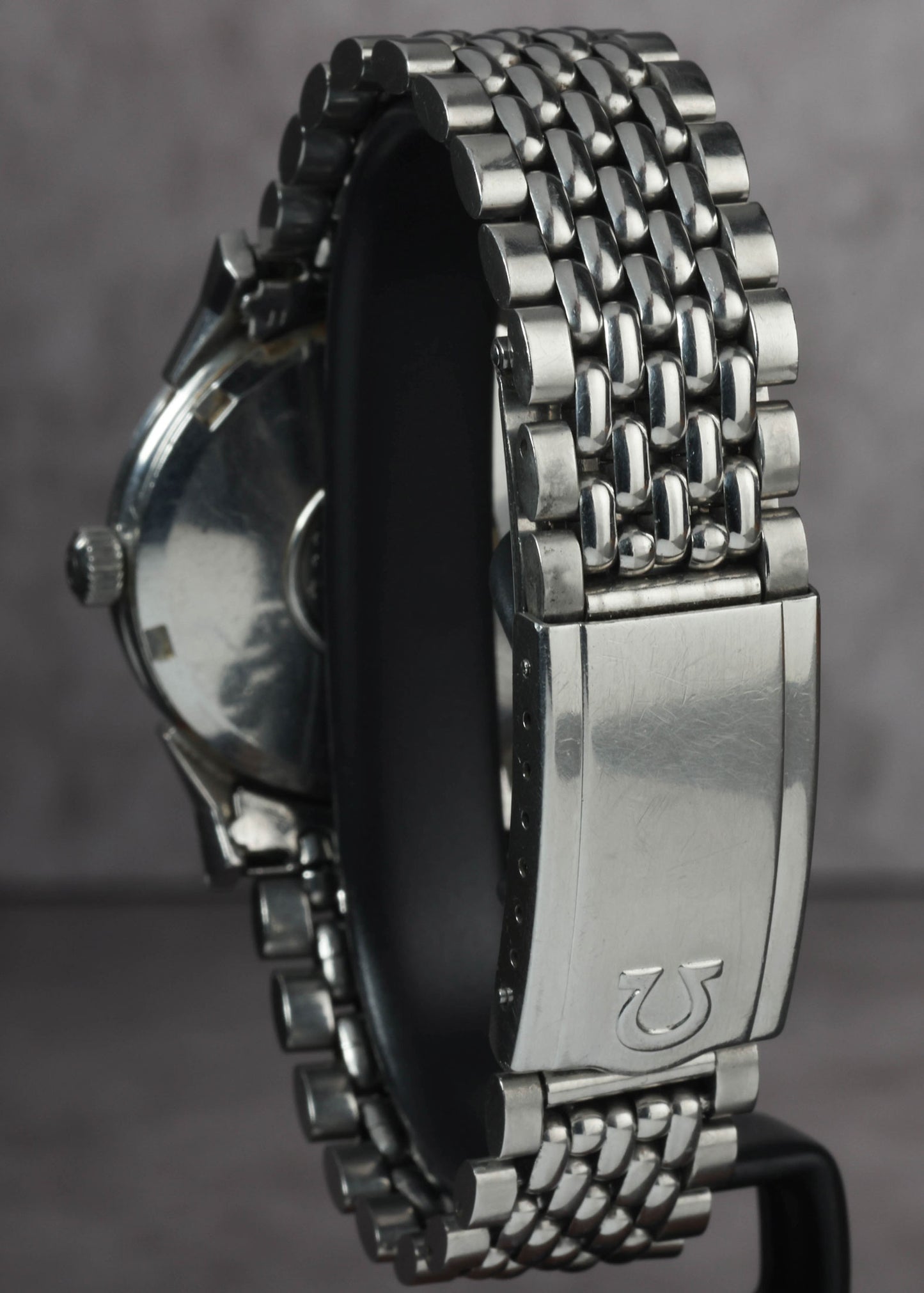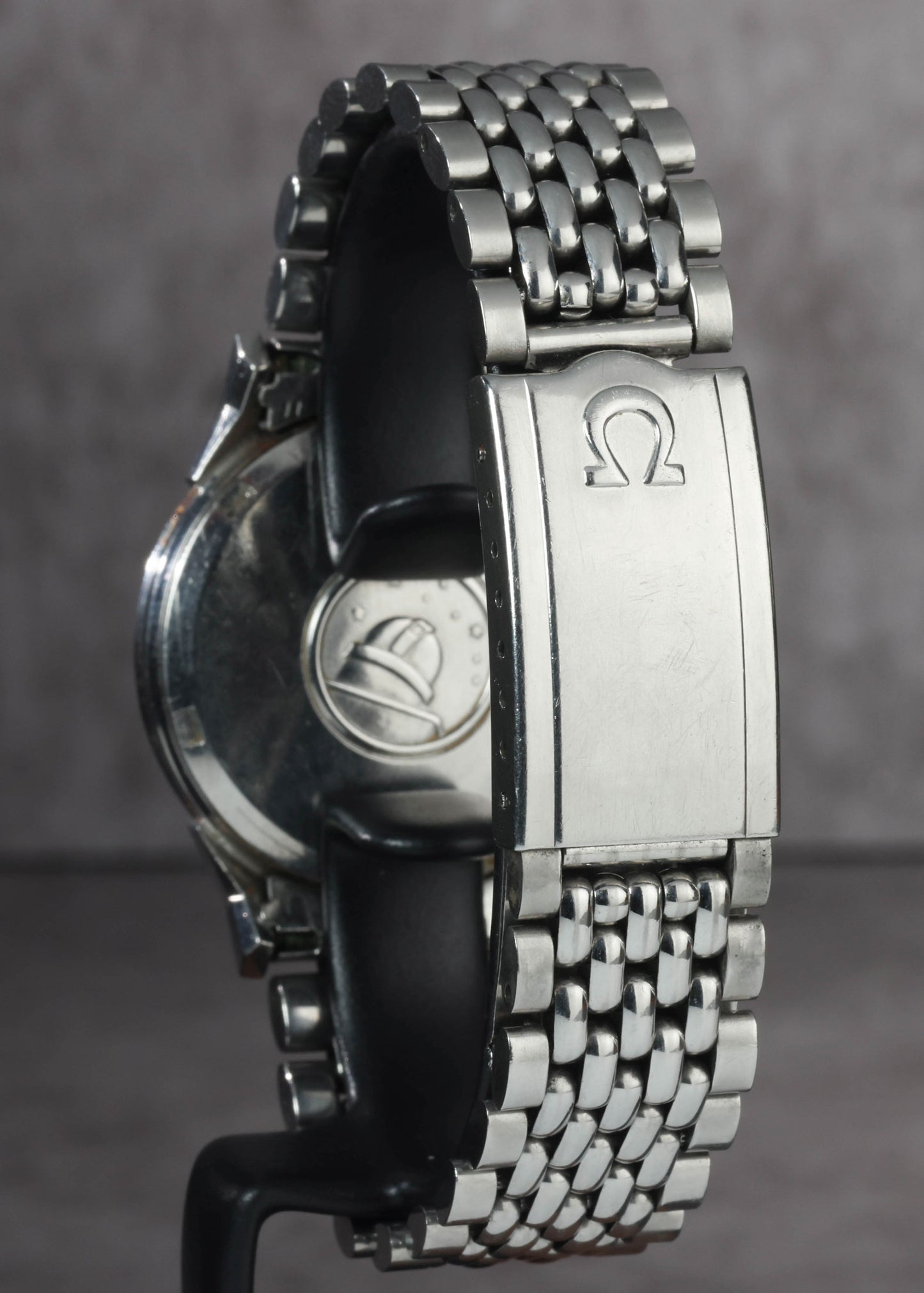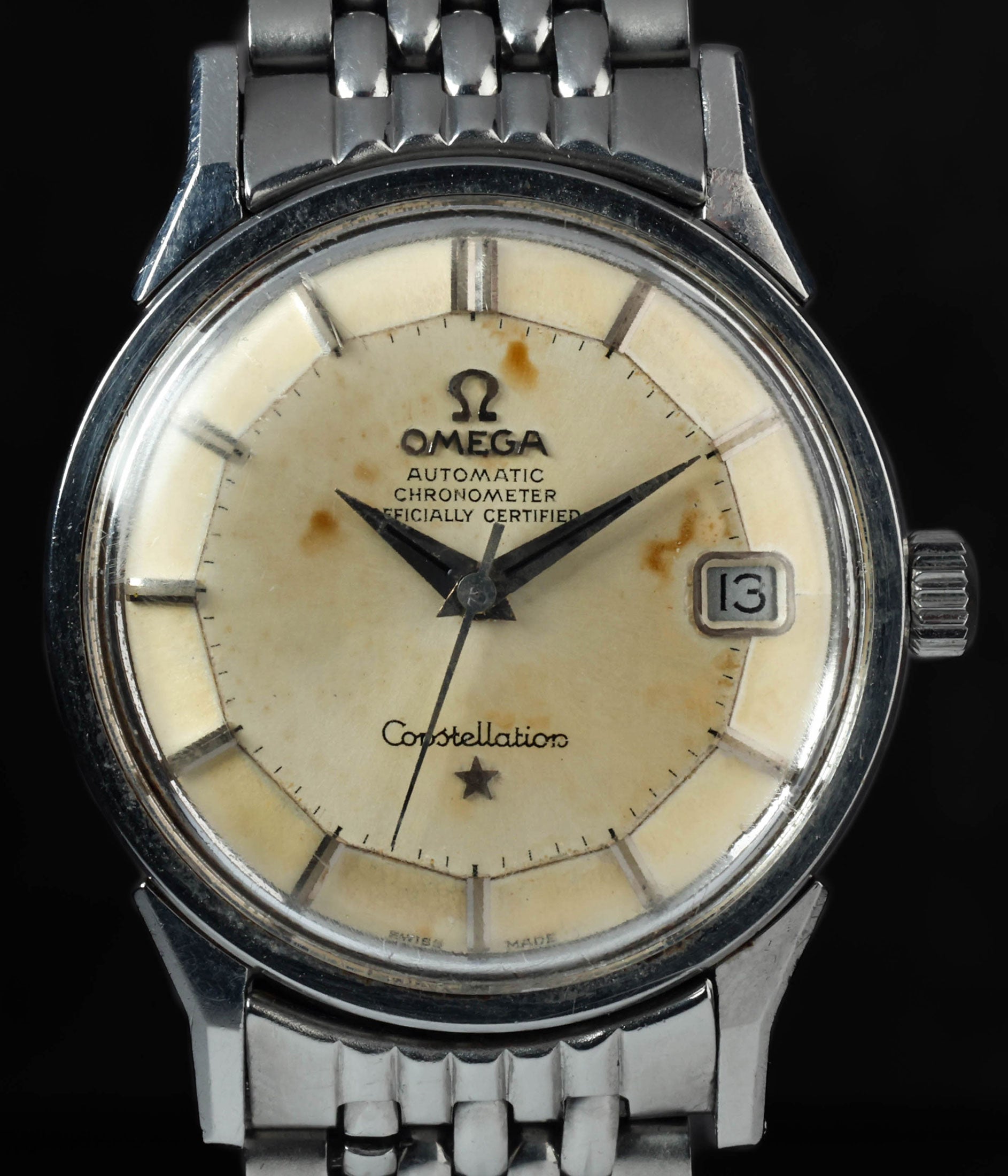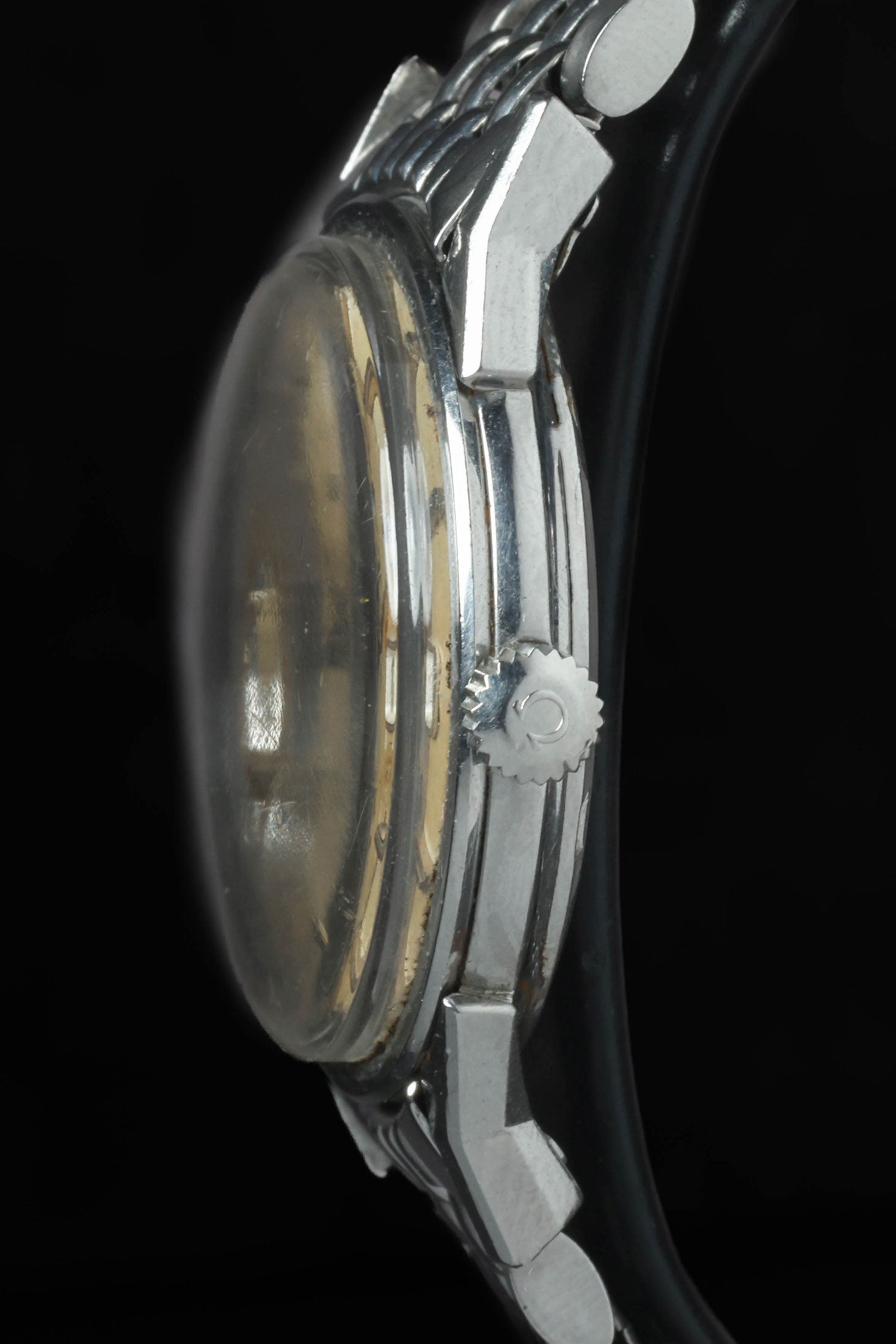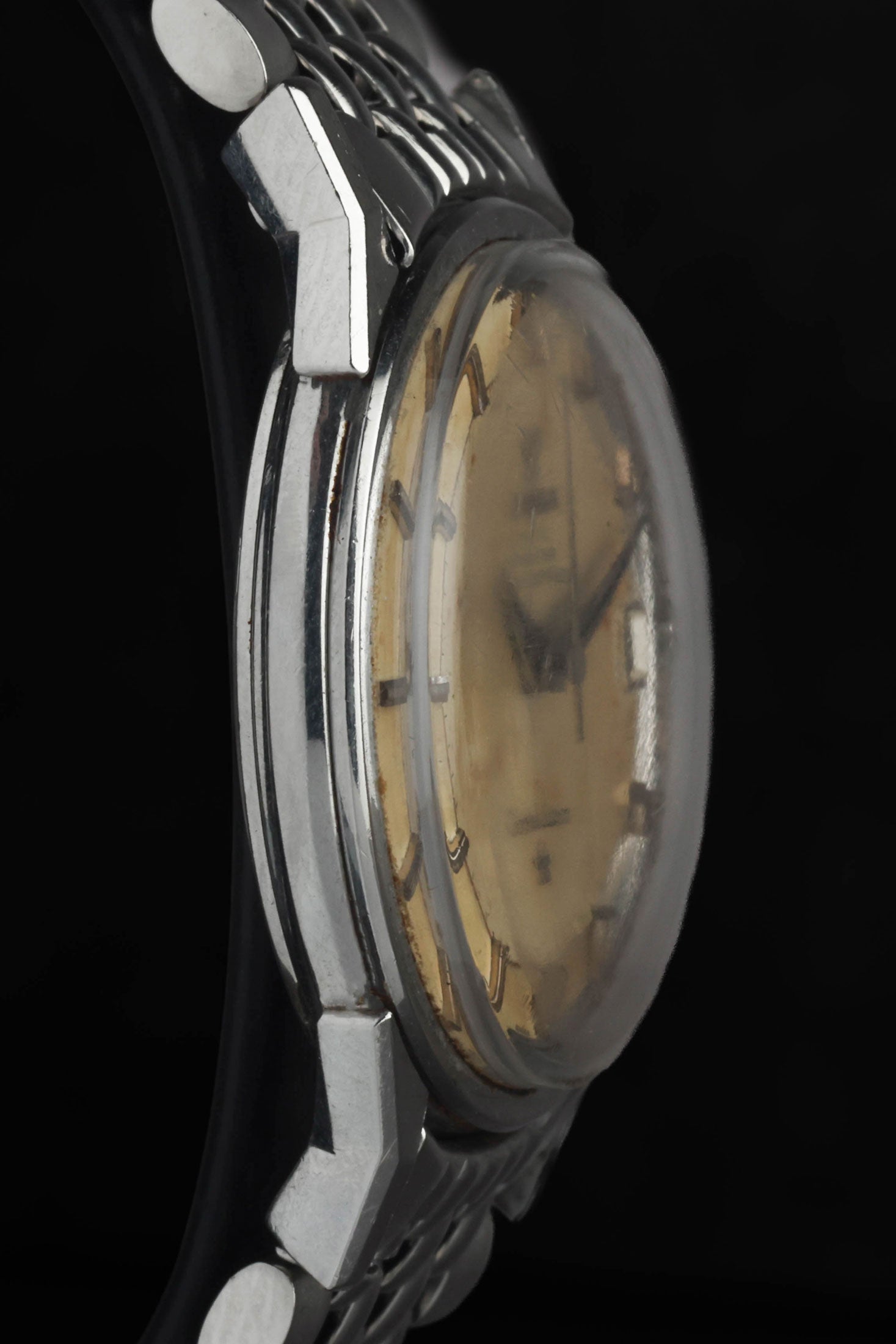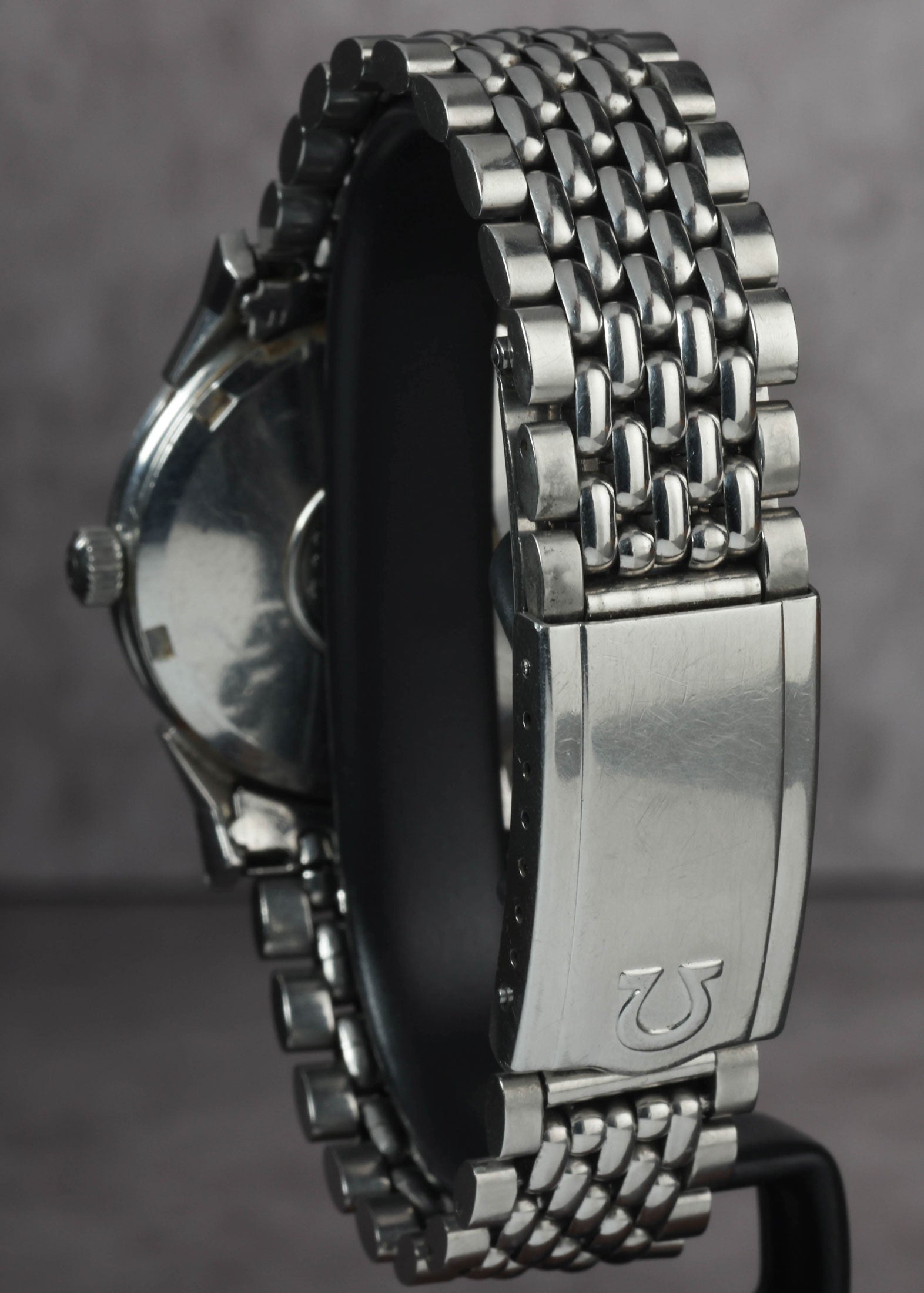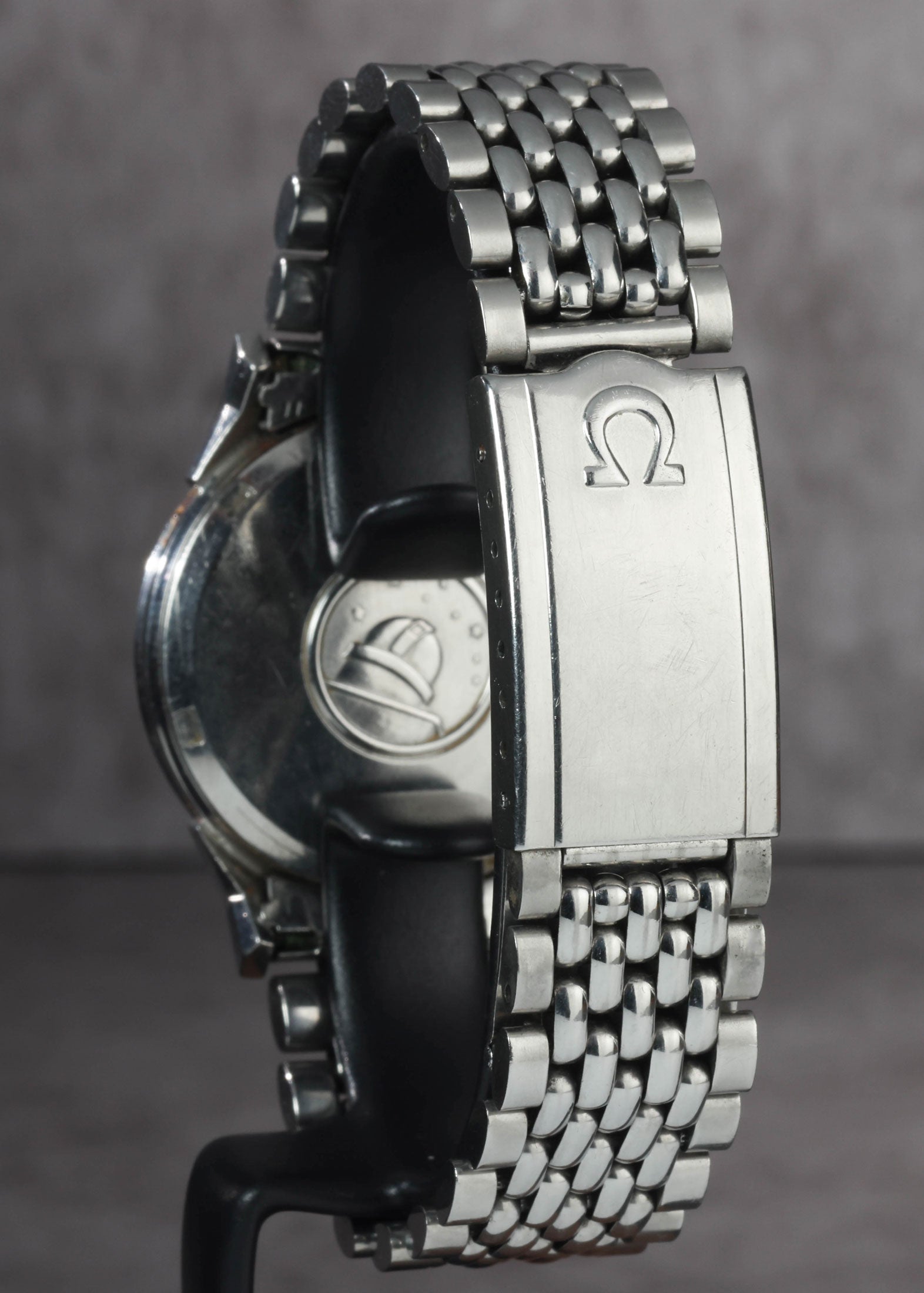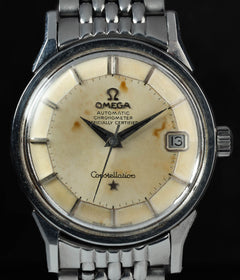Crown Vintage
Omega Constellation Automatic Pie Pan Ref 168.005 Circa 1960s
Omega Constellation Automatic Pie Pan Ref 168.005 Circa 1960s
Couldn't load pickup availability
Omega Constellation Pie Pan 168.005
The case is in good vintage condition, with hairline scratches visible around the sides and lugs, consistent with age and use. The bracelet remains in good condition with some stretch evident, and light hairlines are present on the clasp. The dial is in overall good condition, though some staining is visible under close inspection. The hands show noticeable oxidation, in keeping with the watch’s age and vintage character.
Share
Why we love this watch
Why we love this watch
Omega Constellation 168.005: A Mid-Century Masterpiece
A Legacy of Precision: The Origins of the Constellation Line
The story of the Omega Constellation begins in 1952, when Omega consolidated its chronometric prowess into a single, elite line of dress watches. Having built a formidable reputation through victories in observatory trials at Geneva and Kew-Teddington in the 1940s, Omega saw an opportunity to commercialise its precision-focused innovations. The result was the Constellation—so named to evoke images of stars, observatories, and celestial-level accuracy.
At the time, Omega was competing fiercely with brands like Longines and Rolex for chronometer dominance. But where others relied heavily on marketing, Omega had the test results to prove its claim. The early Constellation models, such as the bumper automatic references 2648 and 2652, were both technically impressive and visually refined, often cased in gold and featuring distinctive dials with applied star emblems and arrowhead indices.
A consistent hallmark of the Constellation line was its adherence to chronometer certification. Every model was fitted with a chronometer-rated movement—most of them adjusted in five positions for maximum accuracy. By the time the 168.005 emerged in the early 1960s, the Constellation had evolved into Omega’s premier offering for those seeking the perfect blend of performance and elegance.
The Reference 168.005 in Focus
Introduced circa 1962, the Omega Constellation 168.005 represents a high point in the model’s history. The reference came housed in a 34mm case with sharp, faceted lugs—commonly referred to as “dog-leg” lugs. These were the work of case manufacturer Huguenin Frères, known for their meticulous execution and geometric complexity. While 34mm may sound modest by today’s standards, the combination of angular lugs and slim bezel gives the watch an impressive wrist presence.
Case materials included stainless steel, gold-capped steel, and solid 18k gold. Some variants featured smooth bezels, while others had fluted or “coin-edge” bezels, depending on the market and case metal. All 168.005 examples used a screw-down caseback, which bore the engraved Constellation medallion—depicting the Geneva Observatory beneath eight stars, a visual tribute to Omega’s chronometric dominance.
Another design detail worth noting is the presence of thin lugs with drilled holes, making strap changes effortless and enhancing the utilitarian side of an otherwise refined timepiece.
The Iconic Pie-Pan Dial
No feature defines the Constellation 168.005 more than its “pie-pan” dial—a multi-faceted design where the outer perimeter slopes down at an angle, much like an inverted pie dish. This architectural approach adds visual depth and has become one of the most recognisable and coveted vintage Omega dial designs.
Dials came in various finishes, including silver sunburst, matte white, and rarely, textured linen. The hour markers were applied, often in 18k gold to match the case, and usually faceted to catch the light. Some featured black onyx inlays, adding contrast and a subtle hint of luxury. A gold star sat proudly above the 6 o’clock marker, with the word “Constellation” printed in script just above it.
Many dials included a crosshair motif, dividing the dial into quadrants—a design cue associated with precision instrumentation. The dauphine hands, thin and faceted, echoed the sharp lines of the case. A date window at 3 o’clock completed the design, framed by a bevelled edge that integrated seamlessly into the overall aesthetic.
Movement: Calibre 564
Powering the 168.005 was the calibre 564—an updated chronometer-rated automatic movement that replaced the earlier calibre 561. Introduced in 1965, the 564 retained all the strengths of its predecessor, including a bi-directional rotor, full balance bridge, and 24 jewels, but introduced one key improvement: a true quickset date function. This allowed the wearer to advance the date independently by pulling the crown to the second position, a practical upgrade over the semi-quickset feature of earlier models.
The 564 beat at 19,800 vibrations per hour and offered a power reserve of approximately 50 hours. It was adjusted in five positions and across temperature changes, meeting the stringent criteria required for chronometer certification. As part of Omega’s esteemed 500-series family, the calibre 564 was known for its durability, reliability, and exceptional accuracy.
In the context of the 1967 Constellation 168.005, the calibre 564 represented the peak of Omega’s mechanical development during the brand’s golden era—offering refined engineering in a beautifully finished package. For collectors, its inclusion adds both historical credibility and daily practicality to the watch.
Market Position and Appeal
When the 168.005 was released, it was aimed squarely at the discerning professional: someone who wanted a dress watch with engineering credibility. It wasn’t a flashy piece. It didn’t need to be. Wearing a Constellation in the 1960s was a quiet signal that you cared about accuracy, quality, and classic design.
Compared to Rolex’s Datejust, the Omega Constellation was often seen as the more elegant and technically advanced choice. It didn’t rely on marketing mystique. It relied on documented chronometric results and finely tuned mechanical engineering.
This model in particular—the 168.005—strikes a balance that makes it uniquely versatile. It has the refinement of a dress watch but also the durability and functionality to be worn daily. Even today, a well-preserved 168.005 fits comfortably into modern wardrobes without feeling dated or out of place.
Dial Variations and Collector Appeal
One of the reasons collectors seek out the 168.005 is the variety of original dials and case metals available. Pie-pan dials are the most sought after, particularly those with the crosshair design, applied gold markers, and onyx detailing. Some examples feature Arabic numerals at 12 or 6 o’clock, while others stick to baton indices.
Collectors favour examples with untouched dials showing only natural patina. Refinished dials significantly reduce collectability and value, as do aftermarket crowns or incorrect date wheels. Because of its success and long production run, original 168.005 examples are still available—but pristine pieces are becoming increasingly rare.
Another hallmark collectors look for is the medallion on the caseback. Sharp details on the observatory and stars suggest a lightly worn watch. The reference number “168.005” is typically engraved inside the caseback, accompanied by the Omega logo and hallmarks appropriate to the case metal.
Final Thoughts
The Omega Constellation 168.005 remains one of the most desirable vintage dress watches ever produced by the brand. It represents an era when Omega was pushing the limits of mechanical accuracy, producing watches that were not only beautiful but also technically advanced.
From the dog-leg lugs to the pie-pan dial, from the calibre 564 movement to the Geneva Observatory caseback, every element of the 168.005 tells a story of quiet sophistication. It is a watch that rewards close inspection and long-term appreciation—not because it is loud or showy, but because it is considered, well-executed, and deeply rooted in Omega’s most authentic values.
Case & Bracelet
Case & Bracelet
Case in good vintage condition, hairlines visible around case. Bracelet in good condition, some stretch visible. Light hairlines on clasp.
Dial & Hands
Dial & Hands
- Dial in good condition. Staining on dial.
- Hands are oxidised.
Warranty & Condition
Warranty & Condition
Crown Vintage Watches provides a minimum 3-month mechanical warranty on pre-owned watches, from the date of purchase.
The warranty covers mechanical defects only.
The warranty does not cover damages such as scratches, finish, crystals, glass, straps (leather, fabric or rubber damage due to wear and tear), damage resulting from wear under conditions exceeding the watch manufacturer’s water resistance limitations, and damage due to physical and or accidental abuse.
Please note, water resistance is neither tested nor guaranteed.
Shipping and insurance costs for warranty returns to us must be covered by the customer. Returns must be shipped via traceable courier. Return shipment must be pre-paid and fully insured. Collect shipping will be refused. In case of loss or damages, the customer is liable.
Our Pledge
At Crown Vintage Watches, we stand by the authenticity of every product we sell. For added peace of mind, customers are welcome to have items independently authenticated at their own expense.
Condition
Due to the nature of vintage timepieces, all watches are sold as is. We will accurately describe the current condition and working order of all watches we sell to the best of our ability.
Shipping & Refund
Shipping & Refund
